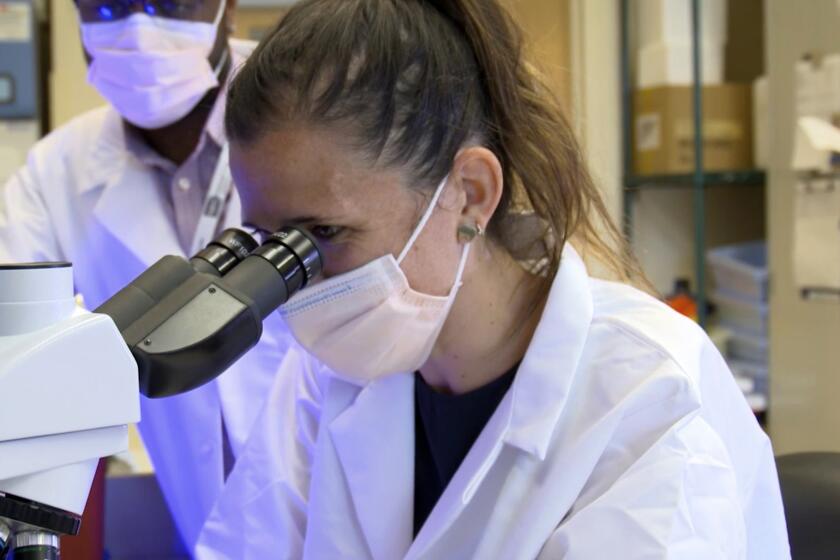Test of Pregnant Women Finds Pesticide Traces
- Share via
A preliminary study of 53 pregnant women in the Los Angeles area has detected for the first time traces of pesticides and other man-made chemicals in amniotic fluid, raising questions--and perhaps undue alarm--about the possible health risks to developing babies.
About a third of the women tested were found to harbor low levels of one or more of the chemicals, which included DDE, a breakdown product of the banned pesticide DDT, and PCBs, a family of chlorine-containing compounds formerly used in electrical transformers. The chemicals were typically present at levels on the order of only one unit of chemical for every 10 billion units of amniotic fluid.
The researchers--from Cedars-Sinai Medical Center and the University of Calgary in Canada--cautioned that they have not studied whether the contaminants may affect the developing fetus, as some other researchers have previously speculated.
“These data cannot be used to make a conclusion that these chemicals are having an adverse effect upon human health,” said Warren Foster, a reproductive toxicologist at Cedars-Sinai. He presented the results Monday at an Endocrine Society conference in San Diego.
“We won’t know what that means for health until we do further research. To speculate would be unethical,” Foster said. He and his associates are hoping to conduct follow-up research to test whether children exposed in the womb to detectable contaminant levels have more health problems than other children. In the meantime, he expressed anxiety that the research could be blown out of proportion and scare people unnecessarily.
Still, the findings are likely to cause a stir, adding new information to the controversial and emotionally charged issue of the potential health effects of low-level exposure to chemical contaminants.
The new work is extremely important, said Theo Colborn, a zoologist at the World Wildlife Fund and a co-author of “Our Stolen Future,” a controversial book arguing that chemicals such as DDE and PCBs are lowering human fertility.
The finding that the chemicals are present in the womb during development fills a gap in the scientific data on human exposure, she said. “Our concern has been that a certain percentage of the population is being affected by chemicals in this way, but the problem has always been that we did not know what was there,” she said.
However, the study’s importance is debatable, other researchers said. Dr. Brian Henderson, a preventive medicine specialist at the USC School of Medicine, said he doubted such low levels of contaminants would affect health.
“It’s hard to imagine the finding has biological significance given there is no other known link between these compounds and birth outcomes and birth defects or cancer” in people, he said.
Stephen Safe, a toxicologist at Texas A & M University, said the finding that only a third of the women tested positive was actually good news: It implied that contamination levels have fallen substantially since their peak in the 1970s, when tests of fat and blood samples suggested that virtually everyone was tainted somewhat.
The study, he said, showed the success of efforts to restrict human exposure to DDT and PCBs, which were banned in the United States in the 1970s.
Foster, of Cedars-Sinai, said he did not know the source of the chemical contaminants that he and his co-workers found in the amniotic fluid. But DDE and PCBs can persist for years in the environment and are known to accumulate in fish and animal fat. Also, some countries still use DDT.
The notion that DDE, PCBs and other chemicals can harm human health even at low doses is based largely on wildlife studies and lab animal tests.
For instance, biologists have found that male alligators exposed to DDE developed malformed penises, presumably because the chemical, which blocks the hormone testosterone, interfered with normal development. Some researchers have proposed that DDE also acts as a “hormone disrupter” in people, possibly contributing to cancers or malformations.
Similarly, PCBs are known to interfere with thyroid function, and if such disruption occurred during development, that might affect brain function, Colborn said.
The samples studied came from healthy women 35 and older who were undergoing routine amniocentesis at Cedars-Sinai.






